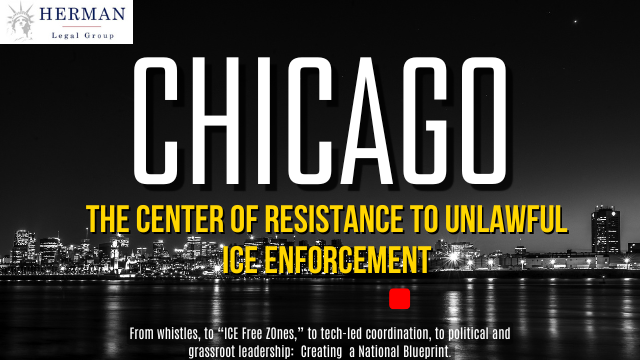By Richard T. Herman, Esq., Immigration Attorney (30 + years)
The Trump administration’s aggressive approach to immigration policy has transformed the landscape of the U.S. immigration court system. From mass ICE raids and border sweeps as part of a broader immigration enforcement campaign, to the expansion of expedited removal proceedings, the administration has prioritized enforcement over due process.
Federal agents have increasingly conducted ICE arrests at courthouses, targeting immigrants attending hearings or seeking protection orders, further eroding trust in the judicial process and raising serious concerns about civil rights violations.
Introduction – A Justice System Turned Inward
In 2025, the U.S. immigration-court system—once described as “America’s hidden judiciary”—has become ground zero in the Trump administration’s campaign to accelerate deportations. Behind the chaos of mass ICE raids and border sweeps lies a quieter, more systemic assault: a legal bureaucracy being refashioned to eliminate checks on executive power.
The administration implemented policies that politicized the courts, transforming them into an enforcement arm of the Department of Justice. Deportations across the U.S. have substantially increased under the Trump administration, further intensifying the impact of these changes. Additionally, the administration has instructed ICE to arrest immigrants at courthouses around the country, further eroding trust in the judicial process.
Unlike federal or state courts, immigration courts operate under the Executive Office for Immigration Review (EOIR)—a component of the U.S. Department of Justice, not the independent judiciary, but rather part of the executive branch of government. That distinction allows a president and attorney general to dictate how, when, and even whether justice is served.
Need to Know:
Every immigration judge ultimately answers to the attorney general, who can hire, fire, or overrule them at will.
At a Glance – The Immigration Courts in 2025
| Metric | 2019 | 2025 |
|---|---|---|
| Pending cases | 1.1 million | 3.6 million + |
| Judges nationwide | ~500 | 750 (> 100 vacancies) |
| Average wait time | ~780 days | 1,400 + days |
| Asylum grant rate | 45 % | 24 % |
Fast Fact:
The EOIR’s pending-case load now exceeds the entire federal criminal docket combined, according to TRAC Syracuse University.
Key Insight:
Rather than insulating judges from politics to manage this crisis, the administration has tightened control, eroding due process and public trust.

How Trump’s Policies Are Reshaping the Immigration Courts
1. Replacing Judges Who Resist “Quota Justice”
Internal DOJ memos obtained by Reuters show judges pressured to decide 1,200 cases per year and “avoid unnecessary continuances.” Dozens who objected were reassigned or replaced. The Trump administration has removed 65 immigration judges from their posts since taking office, further intensifying the pressure on remaining judges. Former judges have voiced concerns that these removals threaten judicial independence and undermine the integrity of the immigration court system. This removal of judges has exacerbated the backlog of immigration court cases, leaving the system increasingly strained. A 2024 analysis found that the quota system influenced judicial behavior, raising concerns about the undermining of judicial independence.
Important Note:
Because EOIR judges are DOJ employees, the attorney general can discipline or terminate them without external review—a power no other U.S. court wields.
Expert Tip:
For attorneys, expect growing regional disparities; some dockets now run on 72-hour removal cycles.
2. “No Jurisdiction over Bond” – Judges Tied by Design
In February 2025, a new EOIR directive expanded the 2019 Matter of M-S- precedent, instructing judges to decline bond jurisdiction for non-citizens in expedited removal or certain detention categories, specifically in removal proceedings involving these individuals. Judges now routinely state on record: “I have no jurisdiction over bond.”
Fast Fact:
Bond hearings once allowed detained immigrants to reunite with family and prepare defense; their elimination means months or years in detention without release.
Key Insight:
This directive does not merely constrain judges—it redefines freedom as a bureaucratic privilege. Advocates including the American Immigration Council warn it violates both Fifth Amendment due process and international human-rights norms, further undermining constitutional rights.
3. A New Tactic – ICE Prosecutors Requesting Dismissals to Enable Expedited Removal
Perhaps the most alarming new practice involves ICE prosecutors themselves requesting case dismissals—not to help immigrants, but to remove them from court protection entirely. These policies have been characterized as an attempt to create a ‘frictionless deportation machine,’ where procedural safeguards are systematically dismantled. As a result, immigration agents are empowered to act more aggressively against those targeted by these policies.
Under the guise of “prosecutorial discretion,” the Department of Homeland Security’s Office of the Principal Legal Advisor (OPLA) has begun filing motions to dismiss thousands of pending cases. Once a judge grants dismissal, ICE regains custody and initiates expedited removal under INA § 235(b)—a process that bypasses judges entirely and is designed to target immigrants for rapid deportation. This process reflects the expansion of ICE enforcement tactics under these new policies.
Fast Fact:
In expedited removal, an immigration officer—not a judge—issues the deportation order; there is no appeal to the BIA and no guaranteed access to counsel.
Key Insight:
By dismissing cases, ICE achieves two objectives: (1) manipulating backlog statistics and (2) stripping due process so immigrants can be deported without a hearing.
A Case Example
A Honduran asylum seeker’s case in Illinois was dismissed in June 2025 at ICE’s request. Two weeks later he was arrested at home, placed in expedited removal, and deported within eight days—before his lawyer could file a motion to reopen.
This scenario is increasingly common for people seeking asylum under the current enforcement regime.
Important Note:
Once a § 240 proceeding is dismissed, EOIR loses jurisdiction. Neither the judge nor the BIA can intervene unless ICE re-files charges—something rarely done.
Expert Tip:
If ICE moves to dismiss your case, your attorney should file a conditional opposition and seek written assurances that no expedited removal will follow, as having experienced legal counsel is critical to protecting your rights and ensuring you are not subject to expedited removal.
“Efficiency” or Erasure?
ICE defends the practice as “resource optimization,” with federal agencies coordinating these efforts to manage case statistics. Yet internal documents reviewed by Politico show its real aim is to boost “case completion rates” while concealing detention-based deportations from EOIR statistics.
Fast Fact:
Tens of thousands of cases have been affected by these policies. More than 32,000 cases have been dismissed at ICE’s request since January 2025—five times the 2024 rate (TRAC Syracuse).
Key Insight:
The backlog isn’t shrinking—it’s being exported into detention centers where justice is invisible.
4. “Rocket Dockets” and Mass Deportation Quotas
Judges in detention facilities are now ordered to complete cases within 72 hours of apprehension. This accelerated timeline increases the risk of mass deportations, as large numbers of individuals may be removed without adequate time for legal defense. For asylum seekers still recovering from trauma or without counsel, that window makes meaningful defense impossible. The Trump administration established a maximum deadline of six months for judges to expedite asylum decisions, further limiting the time available for proper case preparation.
The immigration court backlog grew from over 542,000 in January 2017 to over 1.2 million by January 2021, primarily due to a surge in new cases filed by the Department of Homeland Security. By the end of Trump’s first term, the immigration court backlog totaled over 3.5 million cases, exacerbated by the firing of judges. “Rocket dockets” were first tested in 2018 during family separation and are now permanent as part of the administration’s family separation policy.
Need to Know:
“Rocket dockets” were first tested in 2018 during family separation and are now permanent.
5. Centralizing Power in the Attorney General
The attorney general has resumed using the rare “certification” power to rewrite precedent personally—narrowing eligibility for asylum in domestic-violence and family-based claims and curtailing administrative closure, highlighting the Justice Department’s central role in these changes. Critics argue that the removal of immigration judges who grant a high percentage of asylum claims undermines judicial independence, further consolidating control over the system. The Trump administration also proposed the use of military lawyers as temporary immigration judges, raising concerns about the adequacy of their training and impartiality, and the potential impact on legal representation for immigrants.
Important Note:
With no independent oversight, the attorney general acts as both chief prosecutor and final appellate authority in the same system.
6. Chilling Effect on Judicial Independence
Anonymous judges told The Washington Post they now fear career reprisal for granting too many asylum cases.
One remarked, “We’ve stopped being judges; we’re bureaucrats with gavels.” These developments threaten the constitutional right to a fair hearing, undermining due process and judicial independence.
Key Insight:
The National Association of Immigration Judges calls the current environment a “constitutional crisis of independence.”
The Human Cost – Families Trapped in the Machine
Locked In Without Bond
With bond jurisdiction stripped and dismissal-based detentions rising, thousands of asylum seekers remain in custody for months. Children grow up behind fences; parents languish without hearings. The average wait for an asylum case to be completed in immigration court is four years, leaving families in prolonged uncertainty.
Fast Fact:
The average detained asylum seeker now spends over six months awaiting a hearing (HIAS).
Access to Counsel Shrinking
Because detention centers are remote, only ~15 % of detainees have lawyers. Without bond, many cannot reach representation. This highlights the urgent need for advocates and organizations to provide legal representation to individuals held in detention.
Expert Tip:
Use the AILA Lawyer Search or local pro-bono programs immediately after detention notice; timing is critical for credible-fear interviews and habeas filings.
Before vs After – The Court System Transformed
| Aspect | Before (2020 – 2021) | After (2025) |
|---|---|---|
| Judicial independence | Moderate AG oversight | Extensive AG control; political appointments |
| Bond hearings | Available for most non-criminal cases | Denied for majority of detained |
| Asylum eligibility | Broader interpretation | Narrow definitions |
| Backlog strategy | Add judges | Dismiss cases + expedited removal |
| Judge morale | Low but improving | Crisis-level burnout |
The dramatic growth in the immigration court backlog began during the first Trump administration, when policy changes and enforcement priorities led to a surge in pending cases. This trend has continued, with recent reforms further impacting case processing and judicial workload.
At a Glance:
2025 marks a pivot from adjudication to administration—justice measured in speed, not fairness.
Legal Challenges and Pushback
Non-profits and state AGs have filed lawsuits challenging bond restrictions and mass dismissals as violations of the Immigration and Nationality Act and the Constitution’s Due Process Clause, as well as alleging civil rights violations stemming from discriminatory enforcement practices. Federal courts in Maryland and California have issued limited injunctions, but enforcement continues elsewhere. The Trump administration attempted to implement numerous policies to limit asylum eligibility, which were legally challenged, reflecting the contentious nature of these changes.
In addition to legal challenges, advocacy groups continue to urge Congress and congressional leaders to pass legislation that protects immigrant rights and addresses ongoing concerns. Lawsuits have stopped many illegal Trump administration policies, including those that aimed to separate families at the border and arbitrarily cut off access to asylum. Some of these issues may ultimately be decided by the Supreme Court.
Key Insight:
Even if later overturned, these policies create irreversible harm—families separated, asylum claims lost, and records erased.
How the Legal Community Is Responding
| Firm / Organization | Focus & Strengths | Why Consider Them |
|---|---|---|
| Herman Legal Group | 30 + years defending immigrants nationwide; multilingual team; deep EOIR experience | Personalized defense; full service for court and detention cases |
| Fragomen Worldwide | Global corporate immigration | For multinational employees facing removal |
| National Immigration Law Center | Non-profit impact litigation | Systemic policy challenges |
| Jackson Lewis P.C. | Employer-side compliance | When employer issues overlap with removal |
| Vinson & Elkins LLP | Federal appeals & complex litigation | High-stakes precedent cases |
| Immigrant Legal Resource Center | Legal resources, training, and support for immigrants and advocates; expertise in immigration law and defense strategies | Access to expert guidance and resources for navigating complex immigration issues |
Outlook 2025 & Beyond
Advisers close to the White House have floated plans to move the EOIR under the Department of Homeland Security — making prosecutors and judges part of the same agency. That shift would complete the collapse of judicial independence. A second Trump administration could rapidly expand these changes, threatening temporary protected status, birthright citizenship, and increasing border security measures at the southern border.
The backlog in the immigration courts has already reached historic levels, straining resources and delaying justice. This has significant impacts on border communities and undocumented immigrants, as federal funds are increasingly directed toward enforcement rather than legal protections or support services.
The administration has used the backlog as justification for more aggressive enforcement, but local officials, local government, elected officials, and state law can play critical roles in resisting or supporting these federal policies. At the same time, there is a notable expansion of customs enforcement, immigration and customs enforcement, and the activities of ICE officers and law enforcement, raising concerns about racial profiling and civil rights violations under new enforcement strategies.
In contrast, the Biden administration has attempted to shift some immigration enforcement priorities, but the federal government continues to play a central role in shaping and implementing these policies.
Fast Fact:
Despite record case completions (> 480,000 in FY 2024), the backlog grew by another 400,000 new filings.
Key Insight:
The administration isn’t solving the backlog—it’s using it to justify control.
For Journalists and the Public
- Track data through TRAC Syracuse.
- Amplify judges’ and lawyers’ first-hand accounts.
- Humanize statistics with storytelling.
- Demand transparency on dismissal orders and detention outcomes.
Conclusion – The Court That Isn’t a Court
The phrase “attack on the immigration courts” is no longer metaphor. It is a policy blueprint executed in plain sight: judges stripped of authority, cases dismissed to permit swift expulsion, and bond hearings abolished.
After three decades defending immigrants, I’ve watched how a single fair hearing can change a life. When the system no longer guarantees that chance, justice is not delayed—it’s denied.
Key Takeaways
- Immigration courts remain within DOJ, vulnerable to political control.
- 2025 policies centralize power in the Attorney General and ICE prosecutors.
- Judges declaring “no jurisdiction over bond” leave detainees indefinitely confined.
- ICE dismissals allow re-arrest and expedited removal without hearings.
- Quota-driven “rocket dockets” undermine due process.
- Advocates and firms like Herman Legal Group are fighting back in court.
- Without structural independence, the immigration courts risk becoming an extension of ICE.
Author Bio / Profile

Richard T. Herman, Esq., is an immigration attorney with more than 30 years of experience and founder of the Herman Legal Group, recognized nationally as “The Law Firm for Immigrants.” He co-authored Immigrant, Inc. and is a frequent commentator on immigration policy for major news outlets. Learn more or schedule a consultation here.








Trump’s War on Immigration Courts (2025): How Due Process Is Being Dismantled from the Inside Out